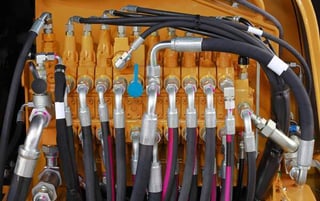 Consider this little known fact: Over 100 million gallons of hydraulic fluid are lost each year due to preventable leaks. So, let's look at the retail price of a 55 gallon drum of hydraulic oil from a well known online distributor: $850. At that cost, we are dumping $84.4 billion of hazardous waste each year. We say 'dumping' because we're not only throwing away 85 billion dollars; we are leaking a tremendous amount of potentially toxic fluid. Chances are most of it is not being properly recycled or reclaimed. Instead, it ends up in the soil of construction sites or down the floor drain in manufacturing plants. And remember the operative word in the first sentence: preventable.
Consider this little known fact: Over 100 million gallons of hydraulic fluid are lost each year due to preventable leaks. So, let's look at the retail price of a 55 gallon drum of hydraulic oil from a well known online distributor: $850. At that cost, we are dumping $84.4 billion of hazardous waste each year. We say 'dumping' because we're not only throwing away 85 billion dollars; we are leaking a tremendous amount of potentially toxic fluid. Chances are most of it is not being properly recycled or reclaimed. Instead, it ends up in the soil of construction sites or down the floor drain in manufacturing plants. And remember the operative word in the first sentence: preventable.
These are the hard costs. Now, lets consider the soft (but very real) costs:
- Maintenance
- Down-time
- EPA fines
- Or worse: a job site or a plant is shut-down for violations
More often than not, leaks are caused at the fitting threads or improper O-ring fittings. Though hoses rupture and burst, frequent selection of the wrong fitting, over or under tightening and improper hose, tube & fitting assembly are the biggest culprits of hydraulic leaks. Threads that are not seated properly and O-rings that are not per specification cause unexpected leaks.
Since most hydraulic leaks are at the threaded connection, let’s look at some typical causes and ideas for prevention. After all, standard fittings are for standard connections in standard applications. And yes, there are many ‘standard’, worry free, applications. Yet most field engineers will tell you that ‘standard’ usually only happens in the lab, not in the field.
This is not only true in hydraulics. For instance, consider a compressed natural gas filling station. The gas runs underground from a compressor to a dispenser (the pump that fills the car or truck), often for many hundreds of feet. The only connectors are compression fittings at the end points of the tube because the NFPA (National Fire Prevention Association) code does not allow for mechanical fittings underground when running high-pressure gas. The only choices underground are connecting multiple sticks of stainless tube with longitudinal welds, or running continuous lengths of seamless coiled tubing, connected at the ends with special compression tube fittings. Without the proper connections, natural gas will leak into the atmosphere.
This blog post is an excerpt from our whitepaper, "Reduce Leak Points with Custom Fittings". Click below to download and read more
Sources:
- Construction Equipment®
- Hydraulics & Pneumatics
- Machinery Lubrication Magazine
- Harvard Business Review

